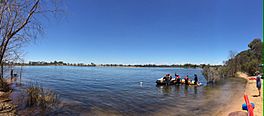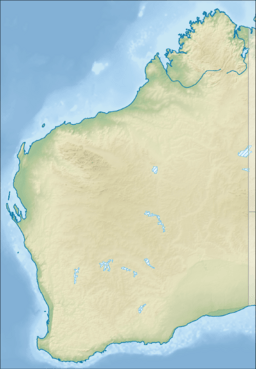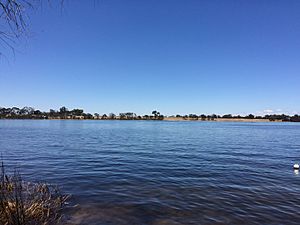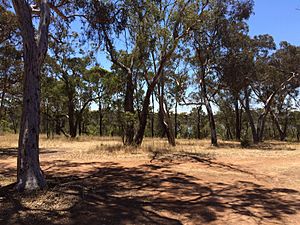Lake Nunijup facts for kids
Quick facts for kids Lake Nunijup |
|
|---|---|

Lake Nunijup December 2018
|
|
| Location | Western Australia |
| Coordinates | 34°24′24″S 117°24′33″E / 34.40667°S 117.40917°E |
| Type | saline |
| Catchment area | 330 ha (820 acres) |
| Basin countries | Australia |
| Max. length | 980 m (3,220 ft) |
| Max. width | 900 m (3,000 ft) |
| Surface area | 76 ha (190 acres) |
| Average depth | 4.4 m (14 ft) (during overflow) |
| Shore length1 | 3,600 m (11,800 ft) |
| Islands | none |
| 1 Shore length is not a well-defined measure. | |
Lake Nunijup is a special kind of lake in Western Australia. It's a salt lake, which means its water is salty. It's also an ephemeral lake, meaning it doesn't always have water. Sometimes it dries up! You can find it about 27 kilometers (about 17 miles) southwest of Cranbrook. It's also about 41 kilometers (about 25 miles) northwest of Mount Barker.
Contents
Understanding Lake Nunijup
Lake Nunijup is part of a larger water system. It gets its water from the Bow River and Kent River areas. These rivers and their smaller streams make up the lake's "catchment." A catchment is like a giant bowl where all the rain and water flow into one main body of water, in this case, Lake Nunijup.
The land around the lake has many other small lakes and swamps. Some water, called brackish water (a mix of fresh and salty), can flow into the lake from the nearby Stirling Range mountains.
Rainfall and Evaporation
This area gets about 499 millimeters (nearly 20 inches) of rain each year. However, a lot of this water disappears! About 1650 millimeters (over 60 inches) of water is lost each year due to evaporation. This is when water turns into vapor and goes into the air.
Between 1973 and 2001, the lake received about 0.72 gigaliters (GL) of water annually. A gigaliter is a billion liters! About 70% of this water evaporated. Another 26% soaked into the sandy bottom of the lake.
Lake Nunijup can hold a lot of water, about 2.32 GL. When it's very full, the water can be up to 4.4 meters (about 14 feet) deep. The lake and its surrounding wetlands are protected areas. They have a special zone of plants around them that helps protect the lake.
History of the Lake
The Noongar peoples are the traditional owners of the land around Lake Nunijup. They have lived in this region for thousands of years. The name Nunijup comes from their language and means "place of the snakes."
Early Settlers
The first European settler to live permanently near the lake was J.B. Parsons. He arrived in 1882 and claimed a large area of land, over 4000 acres, which included part of the lake's edge. Parsons cleared a lot of the land to raise sheep. He was still living on the property in 1929.
Changing Water Levels
In 1940, people thought about using Lake Nunijup's water for the region's water supply. They considered pumping water from Lake Nunijup to another lake called Lake Matilda, which had low water levels at the time.
Lake Nunijup was once a freshwater lake, meaning its water was not salty. But during the 1960s, it became saline (salty). This happened because many trees were cut down in the area, and there was also less rainfall.
The lake usually has water in it, but it doesn't overflow very often. It last overflowed in 1982. Over the past 20 years, the water's saltiness has been around 8000 milligrams per liter (mg/L). This means there are 8 grams of salt in every liter of water.
Today, people use Lake Nunijup for swimming. There's also a parking area and places to have a barbeque.
Plants Around the Lake
The natural plants in the area around Lake Nunijup are mostly jarrah forests (Eucalyptus marginata). You can also find mixed woodlands with jarrah, wandoo (Eucalyptus wandoo), and swamp yate (Eucalyptus occidentalis).
In the swampy areas, there are paperbark trees and banksia woodlands. There are also sedge swamps, which are wet areas with grass-like plants. Sandy areas nearby have a mix of jarrah, marri (Corymbia calophylla), wandoo, and swamp yate trees.
Most of the land around the lake has been cleared for farming. However, right around the lake, you'll find mostly wandoo trees. There are also Melaleuca cuticularis shrubs and a few Baumea juncea plants. In the wetlands, a type of seagrass called Ruppia megacarpa and species of stoneworts (a type of algae) called Nitella are common.
Animals at the Lake
Many different kinds of birds have been seen at Lake Nunijup. Some of these include:




